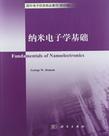纳米电子学基础
2012-6
科学出版社
汉森
385
603250
纳米电子学基础分三个部分,分别在纳米物理学、单电子效应和多电子效应方面进行介绍,内容丰富、论述详实。书中有很多实验结果用来支持文中描述的物理概念,这使读者能够看到概念的真实性以及在实际技术中的重要应用,还有大量的章末问题能加强读者解决问题的能力。纳米电子学基础是第一本真正适用于大学工程和应用科学学生的纳米电子学教科书。
PREFACEPHOTO CREDITSPART Ⅰ FUNDAMNTALS OF NANOSCOPIC PHYSICS1 INTRODUCTION TO NANOELECTRONICS1.1 The"Top-Down"Approach1.1.1 Lithography1.2 The "Bottom-Up"Approach1.3 Why Nanoelectronics?1.4 Nanotechnology Potential1.5 Main Points1.6 Problems2 CLASSICAL PARTICLES,CLASSICAL WAVES,AND QUANTUM PARTICLES2.1 Comparison of Classical and Quantum Systems2.2 Origins of Qnantum Mechanics2.3 Lighl as Wave,Light as a Partic1e2.3.1 Light as a Particle,or Perhaps a Wave-The Early Years2.3.2 A Little Later-Light as a Wave2.3.3 Finally,Light as Quantum Particle2.4 Electrons as Particles.Electrons as Waves2.4.1 Electrons as Particles-The Early Years2.4.2 A Little Later-Electrons(and Everything Else)as Quantum Particles2.4.3 Further Development of Quantum Mechanics2.5 Wavepacket and Uncertainty2.6 Main Points2.7 Problems3 QUANTUM MECHANIS OF ELECTRONS3.1 General Postu1ates of Quantum Mechanics3.1.1 Operators3.1.2 Eigenvalues and Eigenfunctions3.1.3 Hermitian Operators3.1.4 Operators for Quantum Mechanics3.1.5 Measurement Probability3.2 Time-Independent Schr?dinger's Equation3.2.1 Boundary Conditions on the Wavefunction3.3 Analogies Between Quantum Mechanics and Classical Electromagnetics3.4 Probabilistic Current Density3.5 Multiple Particle Systems3.6 Spin and AnguIar Momentum3.7 Main Points3.8 Problems4 FREE AND CONFINED ELECTRONS4.1 Free E1ectrons4.1.1 One-Dimensional Space4.1.2 Three-Dimensional Space4.2 The Free Electron Gas Theory of Metals4.3 Electrons Confined to a Bounded Region of Space and Quantum Numbers4.3.1 One-Dimensional Space4.3.2 Three-Dimensional Space4.3.3 Periodic Boundary Conditions4.4 Fermi Level and Chenmical Potential4.5 Partially Confined E1ectrons??Finite Potential Wells4.5.1 Finite Rectangular well4.5.2 Parabolic Well??Harmonic Oscillator4.5.3 Triangular Well4.6 Electrons Confined to Atoms??The Hydrogen Atom and the Periodic Table4.6.1 The Hydrogen Atom and Quantum Numbers4.6.2 Beyond Hydrogen??Multiple Electron Atoms and the Periodic Table4.7 Quantum Dots,Wires,and Wells4.7.1 Quantum Wells4.7.2 Quantum Wires4.7.3 Quantum Dots4.8 Main Points4.9 Problems5 ELECTRONS SUBJECT TO A PERIODIC POTENTIAL-BAND THEORY OF SOLIDS5.1 Crystalline Materials5.2 Electrons in a Periodic Potential5.3 Kronig-Penney Model of Band Structure5.3.1 Effective Mass5.4 Band Theory of Solids5.4.1 Doping in Semiconductors5.4.2 lnteracting Systems Model5.4.3 The Effect of an Electric Field on Energy Bands5.4.4 Bandstructures of Some Semiconductors5.4.5 Electronic Band Transitions??Interaction of Electromagnetic Energy and Materials5.5 Graphene and Carbon Nanotubes5.5.1 Graphene5.5.2 Carbon Nanotubes5.6 Main Points5.7 ProblemsPART Ⅱ SINGLE-ELECTRON AND FEW-ELECTRON PHENOMENA AND DEVICES6 TUNNEL JUNCTIONS AND APPLICATIONS OF TUNNELING6.1 Tunneling Through a Potentia1 Barrier6.2 Potentia1 Energy Profiles for Materia1 Interfaces6.2.1 Metal-Insulator, Metal-Semiconductor,and Metal-Insulator-Metal Junctions6.3 Applications of Tunneling6.3.1 Field Emission6.3.2 Gate-Oxide Tunneling and Hot Electron Effects in MOSFETs6.3.3 Scanning Tunneling Microscope6.3.4 Double Barrier Tunneling and the Resonant Tunneling Diode6.4 Main Points6.5 Problems7 COULOMB BLOCKADE AND THE SINGLE-ELECTRON TRANSISTOR7.1 Coulomb Blockade7.1.1 Coulomb Blockade in a Nanocapacitor7.1.2 Tunnel Junctions7.1.3 Tunnel Junctions Excited by a Current Source7.1.4 Coulomb Blockade in a Quantum Dot Circuit7.2 The Single-Electron Transistor7.2.1 Single-Electron Transistor Logic7.3 Other SET and FET Structures7.3.1 Carbon Nanotube Transistors (FETs and SETs)7.3.2 Semiconductor Nanowire FETs and SETs7.3.3 Molecular SETs and Molecular Electronics7.4 Main Points7.5 ProblemsPART Ⅲ MANY ELECTRON PHENOMENA8 PARTICLE STATISTICS AND DENSITY OF STATES8.1 Density of States8.1.1 Density of States in Lower Dimensions8.1.2 Density of States in a Semiconductor8.2 Classical and Quantum Statistics8.2.1 Carrier Concentration in Materials8.2.2 The Importance of the Fermi Electrons8.2.3 Equilibrium Carrier Concentration and the Fermi Level in Semiconductors8.3 Main Points8.4 Problems9 MODELS OF SEMICONDUCTOR QUANTUM WELLS,QUANTUM WIRES,AND QUANTUM DOTS9.1 Semiconductor Heterostrures and Quantum Wells9.1.1 Confinement Models and Two-Dimensional Electron Gas9.1.2 Energy Band Transition in Quantum Wells9.2 Quantum Wires and Nanowires9.3 Quantum Dot and Nanoparticles9.3.1 Applications of Semiconducting Quantum Dots9.3.2 Plasmon Resonance and Metallic Nanoparticles9.3.3 Functionalized Metallic Nanoparticles9.4 Fabrication Techniques for Nanostructures9.4.1 Lithography9.4.2 Nanoimprint Lithography9.4.3 Split-Gate Technology9.4.4 Self-Assembly9.5 Main Points9.6 Ptoblems10 NANOWIRES,BALLISTIC TRANSPORT,AND SPIN TRANSPORT10.1 Classical and Semiclassical Transport10.1.1 Classical Theory of Conduction??Free Electron Gas Model10.1.2 Semiclassical Theory of Electrical Conduction??Fermi Gas Model10.1.3 Classical Resisance and Conductance10.1.4 Conductivity of Metallic Nanowires-The Influence of Wire Radius10.2 Ballistic Transport10.2.1 Electron Collisions and Length Scales10.2.2 Ballistic Transport Model10.2.3 Quantum Resistance and Conductance10.2.4 Origin of the Quantum Resistance10.3 Carbon Nanotubes and Nanowires10.3.1 The Effect of Nanoscale Wire Radius on Wave Velocity and Loss10.4 Transport of Spin,and Spintronice10.4.1 The Transport of Spin10.4.2 Spintronic Devices and Applications10.5 Main Points10.6 ProblemsAPPENDIX A SYMBOLS AND ACRONYMSAPPENDIX B PHYSICAL PROPERTIES OF MATERIALSAPPENDIX C CONVENTIONAL MOSFETSAPPENDIX D ANSWERS TO PROBLEMSProblems Chapter2:Classical Particles,Classical Waves,and Quantum ParticlesProblems Chapter3:Quantum Mechanics of ElectronsProblems Chapter4:Free and Corifined ElectronsProblems Chapter5:Electrons Subject to a Periodic Potential??Band Theory of SolidsProhlems Chapter6:Tunnel Junctions and Applications of TunnelingProblems Chapter7:Cou1omb Blockade and the Single-Electron TransistorProblems Chapter8:Particle Statistics and Density of StatesProblems Chapter9:Models of Semiconductor Quantum Wells, Quantum Wires,and Quantum DotsProblems Chapter10:Nanowires, Ballistic Transport,and Spin TransportREFERENCESINDEX
1.2 THE"BoTToM—UP"APPRoACH In 1959,in what can perhaps be called the birth of nanotechnology,influential physicist(andcontributor to the development of quantum theory)Richard Feynman,in a speech deliveredat Caltech titled"There'S Plenty of Room at the Bottom."discussed the technologicalfuture of very small devices.In his speech he asked."What would happen if we could shiftatoms,one by one,and arrange them as we wanted?"Instruments have been developedmore recently that have allowed scientists to do just that—to see and manipulate nano—andatomic—sized objects.These instruments include the scanning electron microscope(SEM),the scanning tunneling microscope(STM),the transmission electron microscope(TEM),and the atomicforce microscope(AFM).In what was a remarkable feat at its time,in 1989scientists at IBM wrote the letters IBM with atoms,by moving individual xenon atoms usingSTM,which has a resolution of approximately 0.1 nm,although it is limited to scanningconducting surfaces.In contrast to the"top—down"approach,this nanoscale building is called the"boaom—up"approach,and represents a much more radical technology shift,which is currentlybeing explored in research laboratories.Of course,moving individual atoms one by one is atime—consuming process,and researchers are looking at more efficient methods of buildingnanoscopic structures.Many avenues are being explored in this regard,including chemicalor biological self—assembly of devices,or mechanical assembly of devices by other smalldevices(called assemblers).Since the objects in question are tiny,often electrophoreticforces,dielectrophoretic forces,and capillary forces can be profitably used.Eric Drexler,inhis 1986 book Engines of Creation:The Coming Era of Nanotechnology,outlines a possiblefuture for nanotechnology and the"bottom—up,'approach that has received a lot of attention.
《纳米电子学基础(影印版)》是国外电子信息精品著作。全书共分10个章节,大致分为三个部分,包括:纳米物理学、单电子效应和多电子效应。本书内容丰富、论述详实,适用于大学工程和应用科学学生。

老师选来当教材的 应该不错